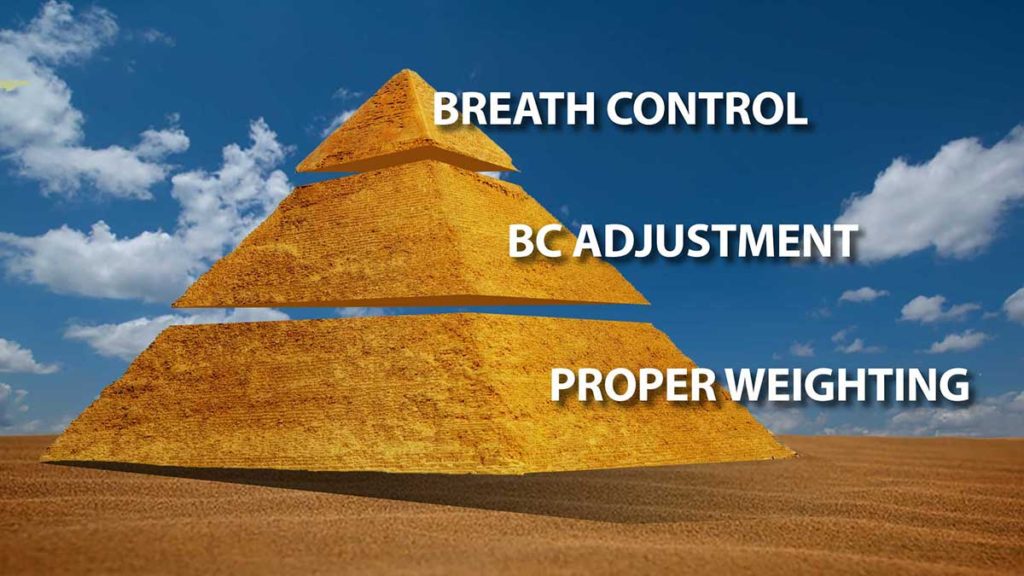To regular readers, it may appear as though we are obsessed with buoyancy control. We are. And with good reason.
Visitors to Blue Grotto often spend hours getting here. In the process, they also spend money on gas, meals and accommodations. They do this not only to experience our well-maintained facilities or to play with our favorite reptile. Blue Grotto’s biggest draw is the exceptional visibility.
Unfortunately, it only takes a single buddy team with poor buoyancy skills to ruin that visibility for everyone. This is why it’s in our best interest to promote a better understanding of buoyancy control.
The root of the problem
Buoyancy control is something that stymies many new divers. The fault lies not in the divers but in what they learned during entry-level training.
Too many divers leave their entry-level course with the impression that buoyancy control revolves solely around pushing buttons on a BC. It doesn’t. BC use is an essential component of buoyancy control, but it is far from the most important part.
Truly mastering buoyancy control requires understanding the Buoyancy Control Pyramid.
The Buoyancy Control Pyramid is a visual representation of the three critical components of buoyancy control. These are:
- Breath control
- BC adjustment
- Proper weighting
It also shows each component’s relative importance to one another.
Breath control
Breath control refers to a diver’s ability to make temporary adjustments in buoyancy by changing how deeply they breathe. Doing so can result in buoyancy changes of up to five pounds or more.
Bear in mind this does not involve holding your breath. You must still breathe continuously — just a little more or less deeply than usual.
A typical use for breath control would be crossing over something like a shallow ridgeline. Rather than vent your BC as you ascend one side of the ridge, you just breathe a little less deeply. This offsets the temporary expansion of your wetsuit. When on the far side of the ridge, you resume normal breathing.
Also, remember that while breath control constitutes one-third of the pyramid’s height, it comprises less than ten percent of the pyramid’s volume. Similarly, breath control generally contributes less than ten percent of what it takes to control buoyancy successfully.
BC adjustment
This is the aspect of buoyancy control that “everybody knows.” But it is not the most important aspect.
- Underwater, you use your BC to compensate for exposure suit compression and expansion. You add air on descent and vent air on ascent.
- How much you need to use your BC is a factor of exposure suit compressibility. Divers wearing relatively thin wetsuits may go through an entire dive without touching their BCs. Similarly, drysuit divers who maintain a constant air volume in their suits throughout the dive will generally not need to touch their BCs underwater.
While BC adjustment constitutes a sizable chunk of the Buoyancy Control Pyramid, this section is still less than half by volume. Similarly, BC adjustment usually comprises less than half of what buoyancy control is all about.
Proper weighting
As the diagram shows, proper weighting is the very foundation of buoyancy control. Divers who strive to wear only the weight that is absolutely necessary will find that maintaining both neutral buoyancy and good body position is almost effortless.
In contrast, people who dive overweighted will find controlling buoyancy a challenge. They will constantly be yo-yoing up and down, struggling to compensate for the expansion and contraction of extra air in their BCs that is there solely to compensate for the unnecessary weight. They are also at greater risk in an emergency.
While proper weighting comprises only one-third of the Buoyancy Control Pyramid’s height, it constitutes over half the volume. Similarly, proper weighting is more than half of the buoyancy control equation.
Your goal should always be to wear the least weight possible. We tackle this topic here.



